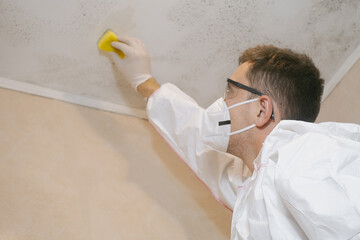
Mold Inspection Staten Island usually starts with a visual examination. The inspector will look for water damage, and he or she will note any discoloration or odors that may indicate a mold problem.
The cost of a mold inspection can be affected by the type of mold present, though a general inspection typically covers the most common species. Additionally, extensive work, such as removing drywall, can increase the cost of an inspection.
1. Close All Windows and Doors
If you have a high moisture level or water damage in your home, an inspector should be called. Moisture is the primary cause of mold and a professional inspection can help you identify and address any issues that may be present.
A mold inspection will begin with a visual assessment and documentation of any visible signs of mold (musty odors, discoloration). An inspector will also look for areas that have moisture problems or potential sources of moisture such as leaky pipes.
A trained professional will be able to determine the extent of the mold problem and recommend effective remediation solutions. An initial mold inspection is especially valuable for homes that have been unoccupied or flipped and may reveal hidden issues such as a plumbing leak. Once the initial mold inspection and remediation is complete, a post-remediation clearance testing will be required to confirm that the mold has been effectively removed.
It is important to close all windows and doors during the inspection so that the inspector can get a thorough measurement of the indoor air quality. In addition, you should avoid vacuuming, dusting and spray disinfectants for two days prior to the inspection to allow a more accurate reading.
Lastly, it is important to turn off your dehumidifier and any other air purification machines as these can significantly interfere with the air quality measurements. These machines remove moisture from the air, which is essential for mold growth. Without adequate ventilation, high humidity levels can build up in your home leading to a high probability of mold. This is a particular concern for homes that have been vacant for long periods of time and bank owned properties.
2. Shut Off All Air Purifiers and Dehumidifiers
Mold growth is a sign of water damage or high moisture levels and is often found on building materials that have become wet. During a visual inspection, the inspector checks all readily accessible surfaces for discoloration and musty odors. Using tools like a thermal imaging camera and hygrometers, the inspector will also test for moisture content in walls, floors, and ceilings. The inspector will also use a surface sampler to collect small samples of mold growth to send to laboratories for testing.
When you’re ready to have a mold inspection, make sure any air purifiers and dehumidifiers are turned off. These devices can actually impede the home inspector’s ability to find hidden mold, as they can cause spores to spread and be dispersed throughout your home or business.
If you’re concerned about mold and want to take proactive measures, start by replacing old insulation, repairing roof leaks, double-checking AC units, and making sure the ventilation system is working properly. Then, schedule a professional mold inspection to identify the scope of your problem and any areas where further action may be needed.
Once the mold testing results come back, the inspector will use the information to recommend an appropriate course of action to remediate the issue and prevent further contamination. In addition, the information will help the homeowner understand the extent of the problem and assess any risk to occupant health. This can be helpful for insurance claims, real estate transactions, and ensuring healthy living environments.
3. Shut Off All Humidifiers
When humidifiers are turned on, they can disperse mold spores into the air. If your home has a humidity control system, be sure to shut it off before the inspector arrives. Air purifiers and dehumidifiers can also help prevent the spread of spores.
If you are unsure whether or not you need to shut these appliances off, talk with your inspector. They can recommend the best course of action to take in your specific situation.
Before conducting a visual inspection, the inspector will test areas prone to moisture using thermal imaging and hygrometers. They will check basements, bathrooms, and heating systems for signs of moisture damage. They will also inspect attics, crawl spaces, and storage areas. Look for water damage, musty odors, and evidence of mold growth on ceiling tiles, walls, and carpeting.
During the inspection, your inspector may collect surface and air samples to be sent to a laboratory for analysis. This process helps identify mold spore levels and determine the type and concentration of mold present in your home.
After the inspection, your inspector will provide you with a detailed report of their findings. If the results indicate a positive presence of mold, your inspector will typically recommend professional mold remediation services.
Having an inspection done before you buy or sell a property can be extremely helpful. It can tell you if there is a existing mold problem, what type of mold it is, and how far the infestation has spread. In addition, it can be used as valuable documentation to support insurance claims and real estate transactions. You should also consider having a post-remediation inspection completed to ensure that the mold was completely removed from the property.
4. Avoid Vacuuming and Dusting
Mold is a necessary part of our ecosystem, but indoors, mold spores can be a health concern. Inhalation of these spores can trigger allergies and even lead to lung issues. Fortunately, there are many preventive measures you can take to protect yourself from harmful indoor mold. One easy thing you can do is to stop vacuuming and dusting. These cleaning activities stir up spores in the air and distort a professional’s test results. It is also important to avoid using scented household cleaners.
If you must vacuum or dust, make sure to perform these tasks outside so that the mold spores are not stirred up and re-saturated in your home. It is recommended to do this for about 24 hours prior to your mold inspection, and ideally longer.
During a mold inspection, an inspector will perform a visual examination of your property paying close attention to any areas of moisture build-up or water damage. This is often the first step in determining whether or not you have a mold issue. Musty odors, discoloration of walls, ceilings, or carpeting are all common indicators of moisture problems and possible mold growth.
After a visual inspection, your inspector will recommend any necessary tests depending on your circumstances. Typical testing includes Spore Trap Air Samples, which involve an air pump that pumps a small volume of air into a “spore trap” cassette with a slide coated in adhesive. Both viable and non-viable spores stick to the slides and are then sent for lab analysis.
Other types of testing include ERMI (Environmental Relative Moldiness Index) samples and EMMA (EMMA – Environmental Mycotoxin Monitoring). These samples involve collecting a dust sample from an HVAC filter to test for the presence of mycotoxins. ERMI testing gives an overall picture of the total number of species and genus detected in the air, while EMMA allows for detection of mycotoxins down to the genus level.
5. Avoid Spray Disinfectants and Bleach
Your home or business needs to be a safe and healthy place for your family and employees. If you’re experiencing musty odors, visual mold growth, or other signs of a mold problem, it’s important to take steps to have the issue identified and corrected quickly.
Certified mold inspectors are qualified to evaluate the presence of mold in a structure, and recommend appropriate action. Depending on the results of your inspection, you may need to clean or replace affected building materials. Mold problems also require the proper remediation procedures to eliminate fungi and prevent future growth.
The first step in the mold testing process is to determine what caused the issue to begin with. Fungi (also known as mold) requires water and a food source in order to grow, so any areas that have a history of water intrusion or moisture are likely to be impacted.
During the walk-through, the inspector will look for any areas of apparent mold growth and note conditions that are conducive to mold. They will also check for signs of water damage or leaks. The inspector will then collect a surface sample from the area of concern, using a swab that’s been dipped in liquid preservative. The swab is then inserted into the tube, and a unique sample number is recorded. The tube is then sealed, and the chain of custody is documented.
Because the natural concentration of mold spores in outdoor air forms a baseline measurement for indoor air quality, the inspector will also take an outside sample for comparison purposes. It’s best to schedule this test for a day when rain isn’t forecast, as rain can introduce additional moisture that could affect the results.
